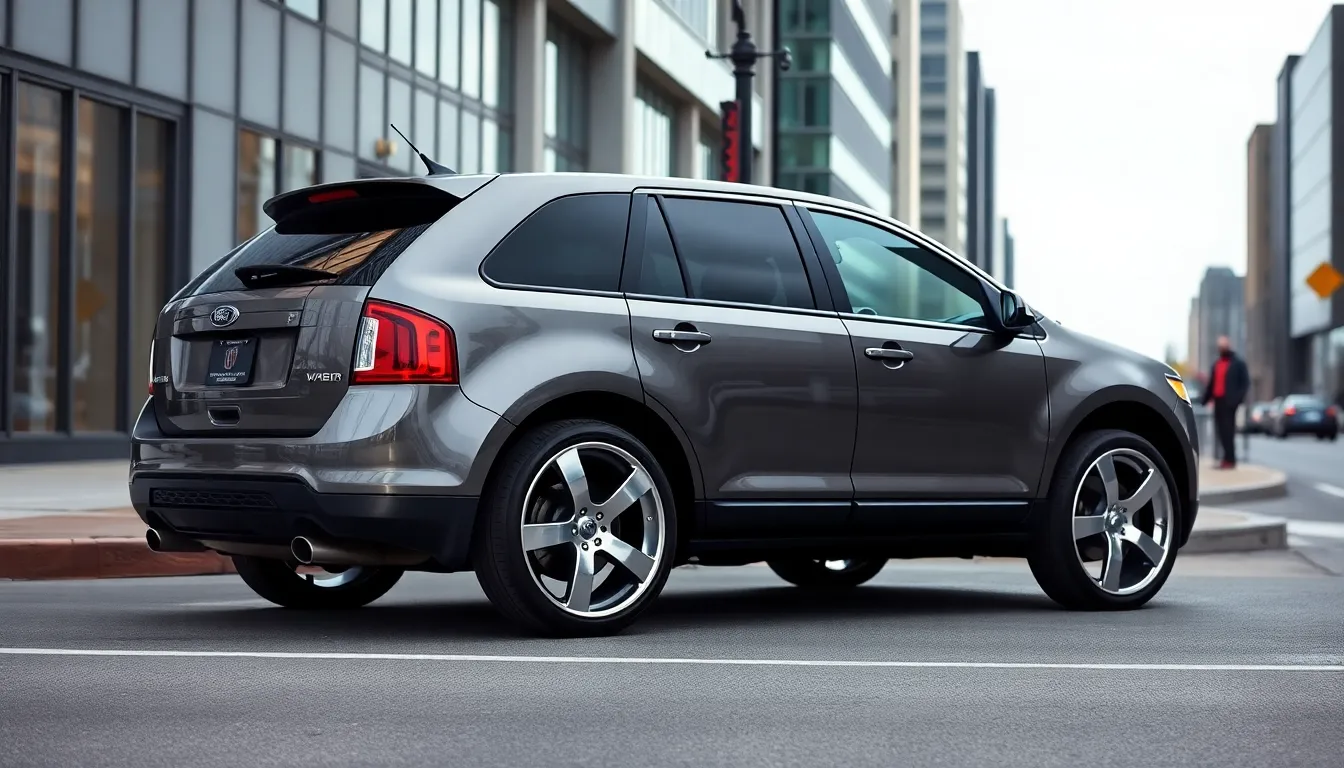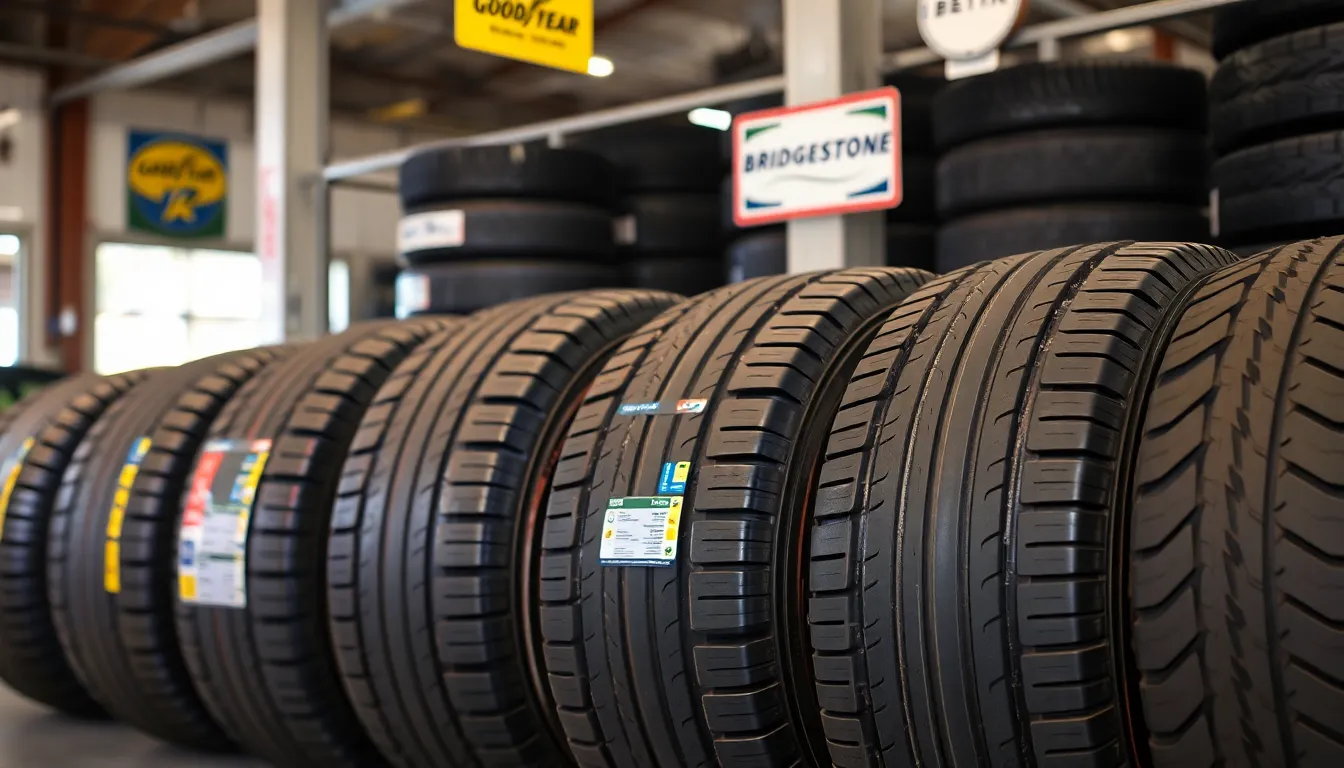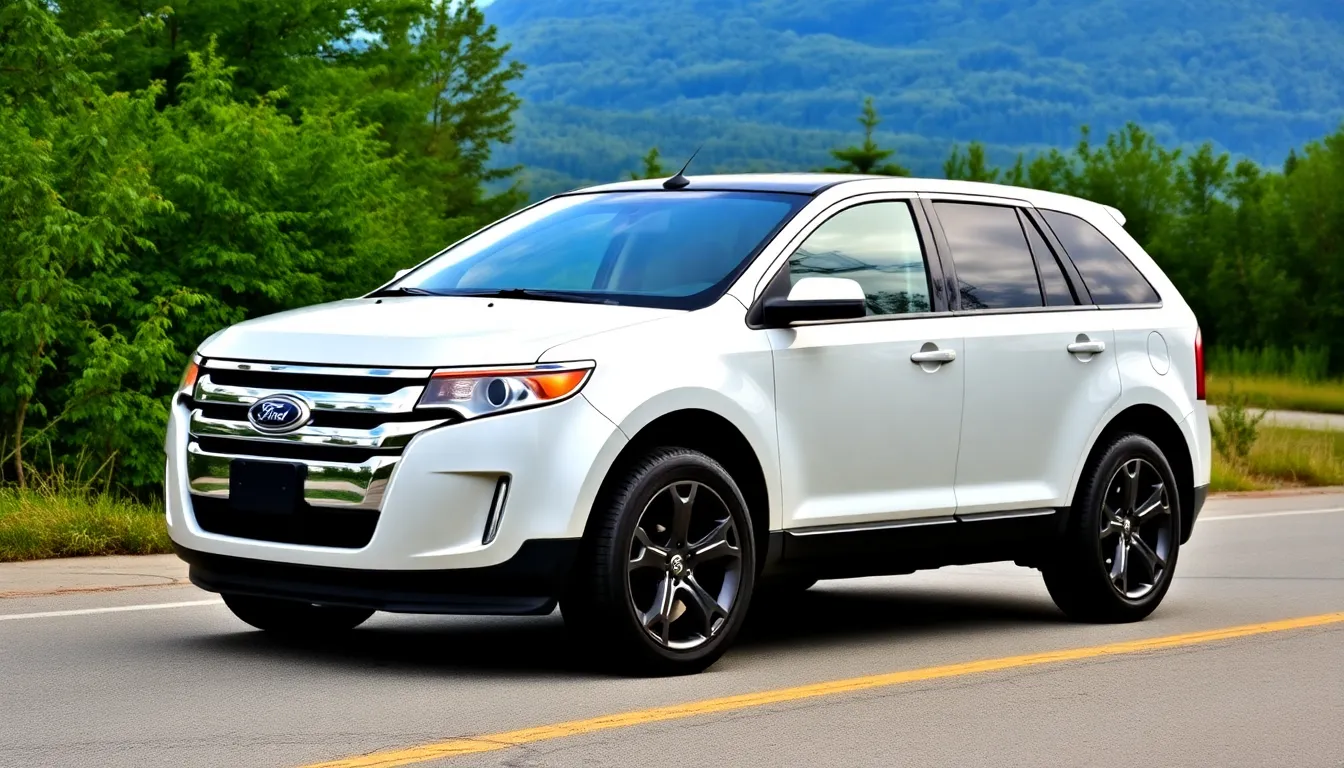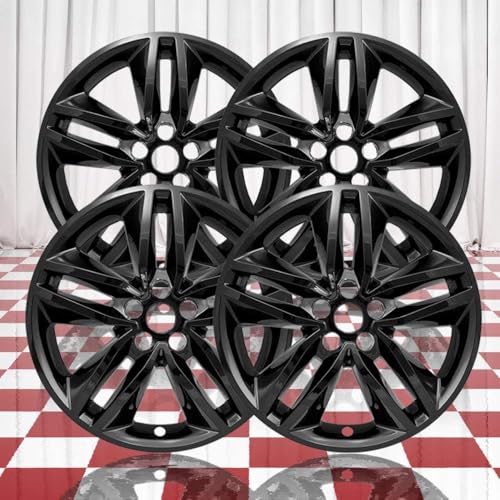Finding the right tire size for your 2013 Ford Edge shouldn’t feel like solving a complex puzzle. We’ve all been there – standing in the tire shop wondering if we’re making the right choice while staring at confusing numbers and letters that seem like a secret code.
Your 2013 Ford Edge deserves the perfect fit, and we’re here to cut through the confusion. Whether you’re replacing worn-out tires or considering an upgrade for better performance, understanding your vehicle’s tire specifications is crucial for safety, fuel efficiency, and optimal driving experience.
We’ll break down everything you need to know about 2013 Ford Edge tire sizes, from decoding those mysterious sidewall markings to exploring your options for different driving conditions. No more guesswork – just clear, actionable information that’ll have you rolling confidently on the right rubber for your SUV.
Understanding the 2013 Ford Edge Factory Tire Specifications
Understanding the factory tire specifications for your 2013 Ford Edge provides the foundation for making informed tire replacement decisions. Ford equipped different Edge trim levels with exact tire sizes to optimize performance characteristics.
Original Equipment Tire Sizes
The 2013 Ford Edge came with three distinct tire size configurations depending on the trim level. Base SE models received 235/65R17 tires that emphasize comfort and fuel economy. SEL trim levels featured 245/60R18 tires providing enhanced handling while maintaining ride quality. Sport models equipped 265/40R22 tires for maximum performance and aggressive styling.
| Trim Level | Tire Size | Focus |
|---|---|---|
| SE | 235/65R17 | Comfort & Economy |
| SEL | 245/60R18 | Balanced Performance |
| Sport | 265/40R22 | Maximum Performance |
Each tire size configuration balances exact performance attributes with the vehicle’s intended use. The narrower 235mm width on SE models reduces rolling resistance for better fuel efficiency. SEL models use 245mm width tires that offer improved traction without significantly impacting fuel economy. Sport variants feature the widest 265mm tires for enhanced cornering stability and road contact.
Wheel Diameter Options
Ford offered three wheel diameter choices across the 2013 Edge lineup to accommodate different driving preferences. The 17-inch wheels on SE models provide the most comfortable ride quality due to taller sidewalls that absorb road imperfections effectively. SEL models received 18-inch wheels balancing comfort with improved steering response and visual appeal. Sport trim featured 22-inch wheels delivering the sharpest handling characteristics and most aggressive appearance.
Larger wheel diameters reduce tire sidewall height, creating firmer ride characteristics and more precise steering feedback. The 17-inch setup offers maximum comfort for daily commuting and highway driving. Moving to 18-inch wheels provides noticeable handling improvements while retaining reasonable ride comfort. The 22-inch Sport wheels prioritize performance and aesthetics over comfort considerations.
Performance Considerations for Different Tire Sizes

Selecting the appropriate tire size for your 2013 Ford Edge directly affects multiple aspects of driving performance. Each tire configuration brings distinct advantages and trade-offs that we’ll examine in detail.
Impact on Fuel Economy
Fuel economy responds differently to each tire size configuration available for the 2013 Ford Edge. The 235/65R17 tires found on SE models deliver the best fuel efficiency due to their reduced rolling resistance and lighter weight. These smaller tires create less drag and require less energy to rotate, translating to improved miles per gallon during daily driving.
Moving to the 245/60R18 tires on SEL and Limited models creates a slight decrease in fuel efficiency. The wider tread contact patch increases rolling resistance, though the difference remains minimal in real-industry driving conditions. Our research indicates this size maintains reasonable fuel economy while offering performance benefits.
Sport models equipped with 265/40R22 tires experience the greatest impact on fuel consumption. The larger diameter and wider profile increase both rolling resistance and overall vehicle weight. Drivers typically see a modest reduction in fuel economy compared to smaller tire sizes, though the difference usually amounts to 1-2 miles per gallon in mixed driving conditions.
Handling and Ride Quality Changes
Handling characteristics transform significantly across the three tire sizes available for the 2013 Ford Edge. The 235/65R17 configuration prioritizes ride comfort with its taller sidewall that absorbs road imperfections effectively. These tires provide a smoother ride over rough surfaces but offer less precise steering response during cornering maneuvers.
The 245/60R18 setup strikes a balance between comfort and performance capabilities. The shorter sidewall compared to 17-inch tires improves steering precision and reduces sidewall flex during turns. Ride quality remains comfortable for daily driving while providing noticeably sharper handling responses than the base tire size.
Sport models with 265/40R22 tires deliver maximum handling performance through their low-profile design and wide tread contact patch. The minimal sidewall height virtually eliminates flex during aggressive cornering, resulting in precise steering feedback and enhanced stability at higher speeds. But, the trade-off includes a stiffer ride quality as the shorter sidewalls transmit more road imperfections directly to the cabin.
Cornering stability improves progressively from the 17-inch to 22-inch configurations, with each size offering distinct benefits for different driving preferences and road conditions.
Popular Tire Size Upgrades for the 2013 Ford Edge

Ford Edge owners frequently choose larger wheel and tire combinations to enhance their vehicle’s appearance and performance characteristics. These upgrades typically involve plus sizing, which increases wheel diameter while reducing tire sidewall height.
Plus Sizing Benefits and Drawbacks
Enhanced aesthetics represent the primary motivation for plus sizing upgrades on the 2013 Ford Edge. Larger wheels create a more aggressive, sporty appearance that transforms the vehicle’s visual profile significantly.
Performance improvements include better handling response and cornering stability due to stiffer sidewalls in lower profile tires. Drivers experience more precise steering feedback and reduced sidewall flex during aggressive driving maneuvers.
Installation flexibility expands with plus sizing, allowing owners to mount high-performance tires that complement the upgraded wheel aesthetics.
Ride comfort deteriorates as the most important drawback of plus sizing upgrades. Lower profile tires absorb less road impact, transmitting more vibrations and harshness to passengers.
Damage vulnerability increases substantially with larger wheels and thinner sidewalls. Potholes and road debris pose greater risks to both tire and wheel integrity, potentially leading to costly repairs.
Fuel economy suffers modestly with plus sizing configurations, particularly when upgrading to wider tire profiles that increase rolling resistance.
Replacement costs escalate with premium tire sizes, often ranging from $200 to $300+ per tire depending on brand and specifications.
Common Aftermarket Size Options
245/50R20 tires replace the standard 245/60R18 configuration on SEL models, providing a sportier appearance with reduced sidewall height while maintaining similar overall diameter.
265/40R21 and 265/40R22 combinations serve as popular upgrades for Sport trim owners seeking enhanced performance aesthetics and handling characteristics.
Bridgestone Ecopia 245/50R20 tires receive recommendations from owners prioritizing smooth, quiet rides, particularly for Limited models equipped with 18-inch wheels.
Premium all-season brands including Michelin, Continental, Goodyear, Pirelli, and Yokohama offer comprehensive options across various price points, typically ranging from $90 to $300+ per tire.
Rolling circumference maintenance remains critical when selecting aftermarket sizes to preserve speedometer accuracy and avoid drivetrain complications.
Best Tire Brands and Models for the 2013 Ford Edge

Established tire manufacturers like Goodyear, Michelin, Bridgestone, Continental, and Pirelli offer exceptional options for the 2013 Ford Edge across all trim configurations. Goodyear stands out as a particularly popular choice among Edge owners, providing comprehensive coverage for the vehicle’s various tire size requirements.
All-Season Tire Recommendations
All-season tires deliver optimal year-round performance for most drivers, combining reliable wet and dry traction with moderate winter capability for mild snow conditions. The Goodyear Assurance WeatherReady leads our recommendations with advanced weather traction technology that adapts to changing road conditions throughout the seasons.
Michelin Premier LTX offers premium construction with EverTread compound technology, ensuring consistent performance as the tire wears down over time. This model excels in wet weather braking and provides excellent tread life for long-term value.
Continental TrueContact Tour rounds out our top all-season selections with ComfortRide technology that reduces road noise while maintaining responsive handling characteristics. The tire’s EcoPlus technology also contributes to improved fuel efficiency across all 2013 Edge configurations.
Performance and Winter Tire Options
Performance-focused drivers and those facing harsh winter conditions benefit from specialized tire categories that address exact driving demands. Performance tires enhance handling precision and steering response, particularly valuable for Sport trim owners or drivers seeking maximum cornering capability.
Pirelli Scorpion Verde All Season Plus combines performance characteristics with environmental consciousness, delivering sharp handling while maintaining all-season versatility. The tire’s low rolling resistance contributes to fuel economy without sacrificing grip performance.
Michelin Pilot Sport A/S 3+ provides track-inspired performance technology in an all-season package, featuring Variable Contact Patch 3.0 for enhanced grip during aggressive driving maneuvers.
Winter tire options become essential for drivers facing harsh snow and ice conditions regularly. Bridgestone Blizzak DM-V2 utilizes Multi-Cell compound technology with bite particles that dig into ice for superior traction compared to all-season alternatives.
Michelin X-Ice Xi3 offers advanced winter compound formulation with Cross Z Sipes technology for enhanced ice grip and braking performance. The tire maintains flexibility in extreme cold temperatures where all-season tires become rigid.
Nokian Hakkapeliitta R3 represents the pinnacle of winter tire technology with Arctic Grip Crystals and Centipede Siping for maximum snow and ice traction, making it ideal for regions with severe winter weather conditions.
Installation and Maintenance Tips

Proper tire maintenance ensures optimal performance and safety for your 2013 Ford Edge. Following these guidelines extends tire life and maximizes your vehicle’s efficiency.
Proper Tire Pressure Guidelines
Maintaining correct tire pressure is crucial for safety, tire longevity, and optimal fuel efficiency in your 2013 Ford Edge. The recommended tire pressure typically ranges around 32-35 PSI, though you must verify the exact specification on your driver’s side door placard or owner’s manual for your exact trim and tire size.
Check tire pressure monthly using a reliable gauge when tires are cold, ideally before driving or at least three hours after your last trip. Cold temperatures reduce pressure by approximately 1-2 PSI for every 10-degree drop, making winter checks particularly important. Overinflated tires create uneven center tread wear and harsh ride quality, while underinflated tires cause excessive sidewall flexing and poor fuel economy.
Digital tire pressure gauges provide more accurate readings than traditional stick gauges, helping you maintain precise PSI levels. Nitrogen inflation offers better pressure retention compared to regular air, though standard air inflation remains perfectly acceptable for most drivers.
Rotation and Alignment Considerations
Regular tire rotation prevents uneven tread wear and maximizes tire lifespan for your 2013 Ford Edge. Rotate tires every 5,000 to 7,500 miles using either an X-pattern for non-directional tires or front-to-back pattern for directional designs.
Non-directional tires allow cross-rotation where front tires move to opposite rear positions and rear tires move to opposite front positions. Directional tires feature exact tread patterns and require straight front-to-back rotation only. AWD models benefit from more frequent rotation intervals due to power distribution across all four wheels.
Proper wheel alignment prevents premature tire wear and ensures correct vehicle handling characteristics. Schedule alignment checks after new tire installations, suspension repairs, or when you notice uneven tire wear patterns. Misalignment causes rapid tread wear on tire edges and creates steering pull during highway driving.
Signs requiring immediate alignment attention include vehicle pulling to one side, steering wheel off-center when driving straight, or irregular wear patterns across tire treads. Professional alignment services typically cost $75-150 but prevent costly premature tire replacement.
Conclusion
We’ve covered everything you need to know about choosing the right tires for your 2013 Ford Edge. From understanding factory specifications to exploring upgrade options each decision impacts your driving experience differently.
Remember that proper maintenance is just as crucial as selecting the right tire size. Regular pressure checks tire rotation and alignment services will maximize your investment and keep you safe on the road.
Whether you stick with factory recommendations or explore aftermarket options we’re confident you now have the knowledge to make an informed choice that matches your driving style and budget.
Frequently Asked Questions
What tire size comes standard on a 2013 Ford Edge?
The standard tire size depends on your trim level. SE models come with 235/65R17 tires, SEL models feature 245/60R18 tires, and Sport models are equipped with 265/40R22 tires. Each size is specifically chosen to optimize performance, fuel economy, and ride comfort for that particular trim level.
Can I upgrade to larger wheels on my 2013 Ford Edge?
Yes, you can upgrade to larger wheels through plus sizing, which increases wheel diameter while reducing tire sidewall height. Popular upgrades include 245/50R20 for SEL models and 265/40R21 or 265/40R22 for Sport models. However, expect decreased ride comfort and slightly reduced fuel economy with larger wheels.
What’s the best tire brand for a 2013 Ford Edge?
Top-rated brands include Goodyear, Michelin, Bridgestone, Continental, and Pirelli. For all-season performance, consider the Goodyear Assurance WeatherReady, Michelin Premier LTX, or Continental TrueContact Tour. These brands offer excellent reliability, performance, and warranty coverage for your Ford Edge.
How often should I rotate tires on my 2013 Ford Edge?
Rotate your tires every 5,000 to 8,000 miles to ensure even tread wear and maximize tire life. Use a front-to-back rotation pattern for non-directional tires, or follow the specific rotation pattern recommended by your tire manufacturer for directional tires.
What tire pressure should I maintain for my 2013 Ford Edge?
Maintain tire pressure between 32-35 PSI for optimal performance, fuel economy, and safety. Check your tire pressure monthly when tires are cold, and always refer to the tire pressure label located on your driver’s side door jamb for the manufacturer’s exact specifications.
Do different tire sizes affect fuel economy on the Ford Edge?
Yes, tire size significantly impacts fuel economy. The 235/65R17 tires on SE models offer the best fuel efficiency due to lower rolling resistance. Larger tires like the 265/40R22 on Sport models reduce fuel economy but provide enhanced handling and performance capabilities.
When should I consider winter tires for my 2013 Ford Edge?
Consider winter tires if you regularly drive in snow, ice, or temperatures below 45°F. Recommended winter options include the Bridgestone Blizzak DM-V2, Michelin X-Ice Xi3, or Nokian Hakkapeliitta R3, which provide superior traction and safety in harsh winter conditions.





